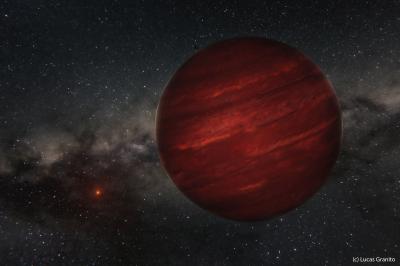Odd planet, so far from its star…

A gas giant has been added to the short list of exoplanets discovered through direct imaging. It is located around GU Psc, a star three times less massive than the Sun and located in the constellation Pisces. The international research team, led by Marie-Ève Naud, a PhD student in the Department of Physics at the Université de Montréal, was able to find this planet by combining observations from the the Gemini Observatories, the Observatoire Mont-Mégantic (OMM), the Canada-France-Hawaii Telescope (CFHT) and the W.M. Keck Observatory Credit: Lucas Granito
A gas giant has been added to the short list of exoplanets discovered through direct imaging. It is located around GU Psc, a star three times less massive than the Sun and located in the constellation Pisces.
The international research team, led by Marie-Ève Naud, a PhD student in the Department of Physics at the Université de Montréal, was able to find this planet by combining observations from the the Gemini Observatories, the Observatoire Mont-Mégantic (OMM), the Canada-France-Hawaii Telescope (CFHT) and the W.M. Keck Observatory.
A distant planet that can be studied in detail
GU Psc b is around 2,000 times the Earth-Sun distance from its star, a record among exoplanets. Given this distance, it takes approximately 80,000 Earth years for GU Psc b to make a complete orbit around its star! The researchers also took advantage of the large distance between the planet and its star to obtain images. By comparing images obtained in different wavelengths (colours) from the OMM and CFHT, they were able to correctly detect the planet.
“Planets are much brighter when viewed in infrared rather than visible light, because their surface temperature is lower compared to other stars,” says Naud. “This allowed us to indentify GU Psc b.”
Knowing where to look
The researchers were looking around GU Psc because the star had just been identified as a member of the young star group AB Doradus. Young stars (only 100 million years old) are prime targets for planetary detection through imaging because the planets around them are still cooling and are therefore brighter.
This does not mean that planets similar to GU Psc b exist in large numbers, as noted by by Étiene Artigau, co-supervisor of Naud's thesis and astrophysicist at the Université de Montréal. “We observed more than 90 stars and found only one planet, so this is truly an astronomical oddity!”
Observing a planet does not directly allow determining its mass. Instead, researchers use theoretical models of planetary evolution to determine its characteristics. The light spectrum of GU Psc b obtained from the Gemini North Observatory in Hawaii was compared to such models to show that it has a temperature of around 800°C. Knowing the age of GU Psc due to its location in AB Doradus, the team was able to determine its mass, which is 9-13 times that of Jupiter.
In the coming years, the astrophysicists hope to detect planets that are similar to GU Psc but much closer to their stars, thanks, among other things, to new instruments such as the GPI (Gemini Planet Imager) recently installed on Gemini South in Chile. The proximity of these planets to their stars will make them much more difficult to observe. GU Psc b is therefore a model for better understanding these objects.
“GU Psc b is a true gift of nature. The large distance that separates it from its star allows it to be studied in depth with a variety of instruments, which will provide a better understanding of giant exoplanets in general,” says René Doyon, co-supervisor of Naud's thesis and OMM Director.
The team has started a project to observe several hundred stars and detect planets lighter than GU Psc b with similar orbits. The discovery of GU Psc, a rare object indeed, raises awareness of the significant distance that can exist between planets and their stars, opening the possibility of searching for planets with powerful infrared cameras using much smaller telescopes such at the one at the Observatoire du Mont-Mégantic.
The researchers also hope to learn more about the abundance of such objects in the next few years, in particular, using GPI instruments, the CFHT's SPIRou, and the James Webb Space Telescope's FGS/NIRISS.
Media Contact
All latest news from the category: Physics and Astronomy
This area deals with the fundamental laws and building blocks of nature and how they interact, the properties and the behavior of matter, and research into space and time and their structures.
innovations-report provides in-depth reports and articles on subjects such as astrophysics, laser technologies, nuclear, quantum, particle and solid-state physics, nanotechnologies, planetary research and findings (Mars, Venus) and developments related to the Hubble Telescope.
Newest articles

Recovering phosphorus from sewage sludge ash
Chemical and heat treatment of sewage sludge can recover phosphorus in a process that could help address the problem of diminishing supplies of phosphorus ores. Valuable supplies of phosphorus could…

Efficient, sustainable and cost-effective hybrid energy storage system for modern power grids
EU project HyFlow: Over three years of research, the consortium of the EU project HyFlow has successfully developed a highly efficient, sustainable, and cost-effective hybrid energy storage system (HESS) that…

After 25 years, researchers uncover genetic cause of rare neurological disease
Some families call it a trial of faith. Others just call it a curse. The progressive neurological disease known as spinocerebellar ataxia 4 (SCA4) is a rare condition, but its…





















